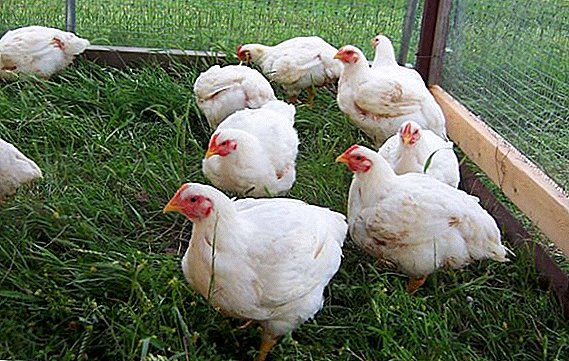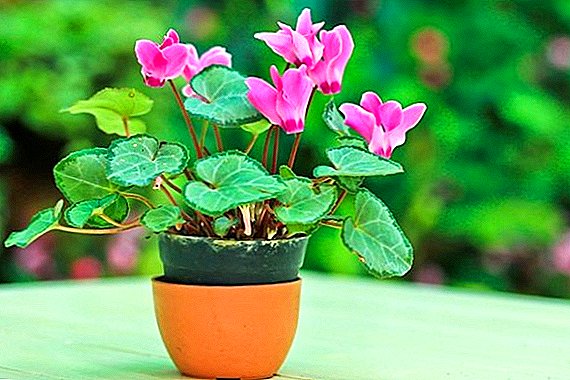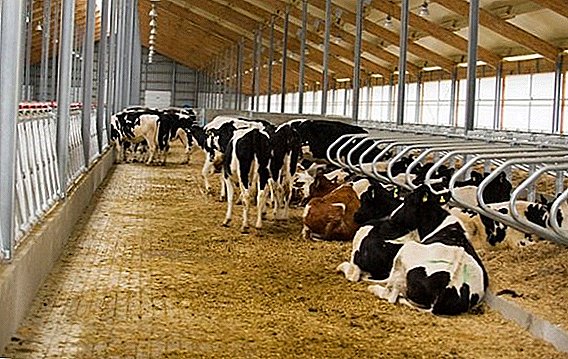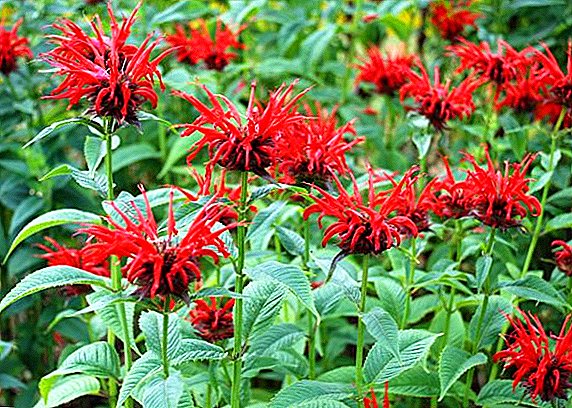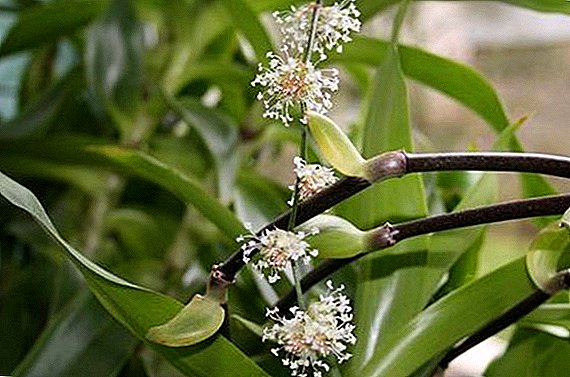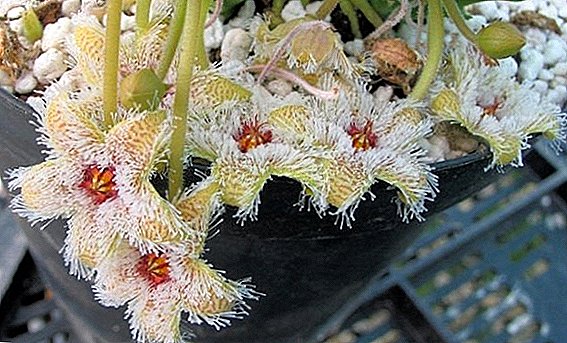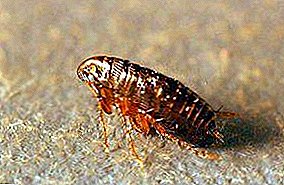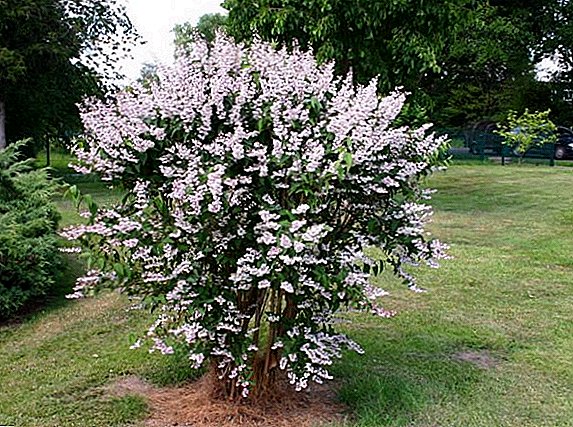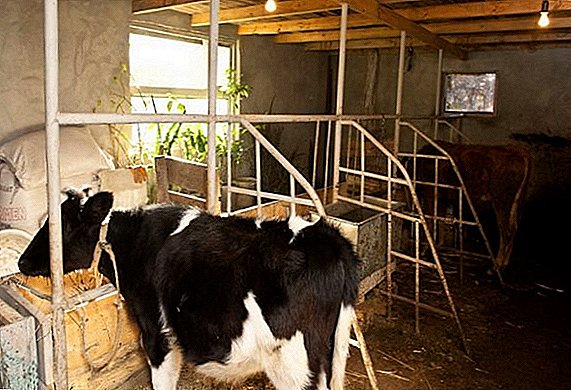 Reliable and convenient livestock feeder - the guarantee of health and good animal productivity and successful work of the farmer. You can create a functional and easy-to-maintain place for feeding cows on your own, with your own hands, by understanding the types of structures and requirements for them. About the features of such manufacturing - further in the article.
Reliable and convenient livestock feeder - the guarantee of health and good animal productivity and successful work of the farmer. You can create a functional and easy-to-maintain place for feeding cows on your own, with your own hands, by understanding the types of structures and requirements for them. About the features of such manufacturing - further in the article.
Requirements for cattle feeders
Designing a place where cows and calves will receive food while in the stall or pasture is a very important point. The main criterion is the need to have separate tanks for dry and wet feed, as well as feeding. Let us consider in more detail the features of different types of structures.
For pasture
During walking in the pasture in the spring and summer period, the cow has the opportunity to independently obtain their own food by eating grass.  In the autumn period, certain difficulties may arise, therefore, farmers should consider the possibility of building a feeding trough or a feeding area for cows, which should have the following characteristics:
In the autumn period, certain difficulties may arise, therefore, farmers should consider the possibility of building a feeding trough or a feeding area for cows, which should have the following characteristics:
- functionality;
- spaciousness;
- easy and not frequent maintenance;
- slight feed loss.
Important! The conical feeder is the safest structure for grazing cows with dry food. Also, its advantages include ease of assembly and operation, strength and durability.Another option of pasture trough is a square cage with crate. It is often used in the household due to its low cost, however, it can be traumatic for an animal due to the risk of its head getting stuck between the rods.
 Maintaining the health and productivity of cows, especially dairy breeds, requires the inclusion of grain and balanced feed in the diet.
Maintaining the health and productivity of cows, especially dairy breeds, requires the inclusion of grain and balanced feed in the diet.Read about how to prepare the territory for grazing.
For convenience and the least loss of this type of food, as a rule, use automatic feeders - devices that minimize the loss of raw materials and provide access to the required amount of food. They are indispensable assistants in growing calves in a stall. 
For stall
When organizing a place for feeding indoors, it is necessary to act, taking into account such factors:
- number of livestock;
- type of cows;
- technical or manual terms of service.
If the farm has a large number of livestock, it is rational to use automatic feed handlers on the table, and in small ones it is more convenient to use a mounted feed box, replenishing stocks manually.  For feeding cows in a stall, it is necessary to create a table - a structure raised 15-30 cm above the floor, usually fenced with low walls (up to 50 cm). The wall prevents the fall of dry food under the feet of the cows, and also serves as a barrier, protecting the cleanliness of the table and hay from the manure that lies on the floor.
For feeding cows in a stall, it is necessary to create a table - a structure raised 15-30 cm above the floor, usually fenced with low walls (up to 50 cm). The wall prevents the fall of dry food under the feet of the cows, and also serves as a barrier, protecting the cleanliness of the table and hay from the manure that lies on the floor.
Learn how to make a drinker for cows.
Tables for hay, if animals have the ability to move freely in the barn, can be:
- vertical. Feeding trough with straight grids allows animals to move freely and is a more convenient design for cows;
- oblique. This design has inclined rods; cows are in a certain fixed position during food intake and do not move freely;
- automatic. The most expensive design, which has such an advantage as the possibility of fixing the animal for veterinary inspection. If necessary, the cow can be fixed in one or another necessary position.
If the animals are in the same place, it is enough to organize a simple feeding trough.  It is worth noting the need to use different containers for different types of food - coarse and liquid. Stall feeder can be made independently.
It is worth noting the need to use different containers for different types of food - coarse and liquid. Stall feeder can be made independently.
Did you know? In order to protect the youngsters from the desire of older relatives to eat their portion of food, in conditions of joint keeping of adults and young individuals in the same room, experienced farmers recommend installing automatic feeders with limiters. Calves will be able to easily stick their heads into the feeder, and the brute will not be able to do this larger than this.
Types of designs
Feeder designs may vary depending on:
- the type of feed for which it will be used;
- material that is used in the process of its manufacture;
- the number of livestock for which it is created.
Under the hay
Dry feed in the form of mowed and dried grass is mandatory for feeding cows, as it can compensate for the lack of fresh greenery during the cold season. For convenience and rationality of using hay, special feeders for livestock are organized on walking spaces - as a rule, they have a conical shape. This is convenient for animals that can freely approach the feeding trough and is, as needed, in addition, it is comfortable to maintain such a design.  Conical structures have several advantages over traditional wooden cages:
Conical structures have several advantages over traditional wooden cages:
- ease of assembly;
- safety for animals - the risk of injury is maximally reduced;
- durability;
- trough strength.
We recommend to learn how to feed dry and milk cows, as well as how to make a winter diet for a cow.
Under feed and grain
A varied diet is the key to good health and high productivity of the cow. In order to enrich the cattle diet with necessary vitamins and microelements, it should be fed her grain and compound feed. Automatic feeders are highly popular for this type of feed. Their merits can be called:
- Low percentage of feed loss.
- An easy way to provide the right amount of food for a cow.
- Especially often auto feeders are used in farms where young animals are bred.
 Auto Feeder with Animal Recognition System: 1 - feed bin; 2 - control station; 3 - antenna; 4 - pulse sensor; 5 - bowl feeder; 6 - screw feeder.
Auto Feeder with Animal Recognition System: 1 - feed bin; 2 - control station; 3 - antenna; 4 - pulse sensor; 5 - bowl feeder; 6 - screw feeder.How to make a cow feeder for yourself
There are many ways to make a cattle feeder yourself. We consider the most simple and popular ways.
From wood
Materials required for the manufacture of a wooden trough for 6 livestock:
- 8 wooden planks with dimensions of 15 cm x 4 cm x 6 m;
- 1 board 10 cm x 4 cm x 6 m;
- 6 boards 15 cm x 4 cm x 40 cm;
- 1 kg of nails 100 mm.
Instruments:
- roulette;
- pencil;
- Circular Saw;
- corner carpentry;
- long ruler;
- ropes;
- hammer.
Production steps:
- Churn together 3 wooden boards so that you get one long canvas by placing a 10 cm wide board between the other two. This part will serve as the front side of the feed trough.
- In the same way, connect the 3 wooden boards that will serve as the bottom of the structure.
- Similarly, we connect another 3 boards, after which we get the back.
- We assemble the construction - we nail the front and rear walls to the bottom with the help of wooden bars. Thus, we get a structure in which the front wall of the trough is 5 cm below the back.
- We roll 2 sides, each of which we make from 3 boards 40 cm long, and we nail them to the overall structure.
- Those parts of the wooden structure, with the help of which its parts were connected, bars with excessive roughness should be cleaned with a circular saw at an angle of 45 ° so that they become smoother and could not cause injury to the animal.



Video: How to make a cow feeder
Of metal
Materials that will be needed to create a group feeder of metal elements:
- 13 metal pipes with a diameter of 19 mm;
- paintwork material;
- fittings, rods with a diameter of 8 mm.
Instruments:
- welding machine;
- Bulgarian.
 Group Capacity Drawing Production steps:
Group Capacity Drawing Production steps:
- To make preparatory measures for cutting the pipe using a grinder.
- First, we take 13 pipes with a diameter of 19 mm. They should make 3 pieces of 201 cm, 2 pieces of 90 cm, 4 pieces of 68 cm, 4 pieces of 35 cm.
- For the manufacture of the frame of the feeder, the tube should be cut 13 mm into such parts: 2 pieces of 205 mm each, 2 pieces of 55 mm each, 26 pieces of 68 cm.
- To assemble the framework, it is necessary to weld 4 pipes: 2 by 201 cm and 2 by 68 cm - you should get a rectangular structure.
- Then, 4 legs of 35 cm each are welded to the resulting blank.
- To ensure the stability of the structure, weld blanks of 68 cm between them.
- At the end of the installation, pipes of 201 cm are welded. It is important that the pipes, which are installed in a vertical position, are located at the end of the base. The remaining pipe is fixed between them. At this assembly of the base is completed.
- Build hay containers. It is necessary to weld a rectangle of 55 and 205 cm segments and weld the resulting construction to the highest point of the pipes, which are located vertically.
- Installation of reinforcement between the lower tube and the upper rectangle.
- Painting metal construction.
Important! For painting metal feeders, you can use only safe and ecological paint.
Making a cattle feeder is a time consuming process, however, a home-made construction for domestic cows will last a long time, will be cost effective and convenient to use.


